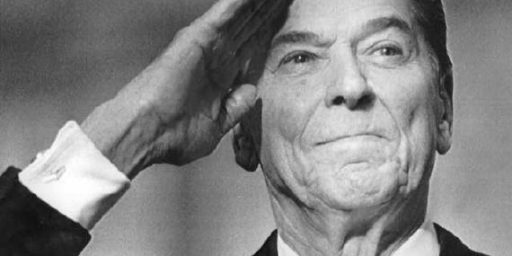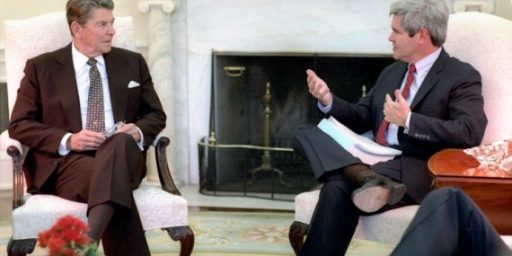A Nation Divided?
Today’s WaPo fronts the first installment of a three-part series, AMERICA IN RED AND BLUE: A Nation Divided
From Congress to the airwaves to the bestseller lists, American politics appears to be hardening into uncompromising camps, increasingly identified with the two parties. According to a growing consensus of political scientists, demographers and strategists, the near-stalemate of 2000 — which produced a virtual tie for the White House, a 50-50 Senate and a narrow Republican edge in the House of Representatives — was no accident.
This split is nurtured by the marketing efforts of the major parties, which increasingly aim pinpoint messages to certain demographic groups, rather than seeking broadly appealing new themes. It is reinforced by technology, geography and strategy. And now it is driving the presidential campaign, and explains why many experts anticipate a particularly bitter and divisive election.
***
Hans Noel, a political scientist at the University of California at Los Angeles, is the author of a paper called “The Road to Red and Blue America.” In an interview, he said, “Most people say they are ‘moderate,’ but in fact the country is polarized around strong conservative and liberal positions.” For the first time in generations, he said, those philosophical lines correspond to party lines. The once-hardy species of conservative Democrats — so numerous in the 1980s they had a name, “Reagan Democrats” — is now on the endangered list, along with the liberal “Rockefeller Republicans.”
“It has taken 40 or 50 years to work itself out, but the ideological division in America — which is not new — is now lined up with the party division,” Noel said.
At the same time, more and more Americans in a highly mobile society are choosing to live among like-minded people. University of Maryland political demographer James Gimpel has documented the rise of a “patchwork nation,” in which political like attracts like, and ideologically diverse communities are giving way to same-thinking islands. A recent analysis sponsored by the Austin American-Statesman, comparing the photo-finish elections of 1976 and 2000, made this clear. While the nationwide results were extremely close, nearly twice as many voters now live in counties where one candidate or the other won by a landslide. Person by person, family by family, America is engaging in voluntary political segregation.
As it becomes more difficult to reach across the party line, campaigns are devoting more energy to firing up their hard-core supporters. For voters in the middle, this election may aggravate their feeling that politics no longer speaks to them, that it has become a dialogue of the deaf, a rant of uncompromising extremes.
***
Finally, because the Red-Blue divide so often follows very personal values — matters of philosophy, spirituality, morals and taste — the coming election appears primed to leave the losing faction not just disappointed, but angry. There’s a reason why the last two presidents, Bill Clinton and George W. Bush, have driven their opposition into fits of loathing: Politics in Red-Blue America is less the art of compromise than a clash of cultures.
So, Pat Buchanan was right, if a bit premature, in asserting at the 1992 GOP convention that we were in the midst of a “cultural war”?
Much of this is overblown. Certainly, the country isn’t as bitterly divided now as in the late 1960s. What has happened is a party realignment that took decades. For a generation, we had a large contingent of Southern Democrats that weren’t really Democrats and Northeastern Republicans that weren’t really Republicans. Most of those people are now in their natural parties. And our two parties are still much closer together than, say, CDU and SPD in Germany or Labour and Conservative in the United Kingdom.
While the political discourse is far more civil in our tone than during the periods marking the formation of the party system in the late 18th century and certainly during the decades leading up to and just after the Civil War, there has been a ratcheting up of vitriol by recent standards. The explanations given for the phenomenon are plausible and familiar:
• Reagan happened. Republican presidents Dwight D. Eisenhower, Richard M. Nixon and Gerald R. Ford governed essentially as pragmatic centrists, but Reagan framed his presidency in ideological terms. He coaxed religious conservatives and Cold Warriors away from the Democratic Party while making it uncomfortable for liberals to remain in the GOP. “The signals coming out from Washington helped voters sort themselves out into parties that reflected their world view,†explained Thomas E. Mann of the Brookings Institution.
• Peace happened. From the outbreak of World War II through the end of the Cold War — a span of nearly 50 years — the United States’ foreign policy and military policy, two of the biggest responsibilities of the government, reflected the consensus of both parties. “In the 1950s, the country thought of itself as homogenous,†said White, recalling sociologist Daniel Bell’s influential 1960 book, “The End of Ideology.†“The dominant discussion was about the need for unity in the face of a potent enemy.†The collapse of the Soviet Union stripped much of the purpose out of centrism.
• Clinton happened. Though he campaigned as a moderate Democrat, and delivered on such longtime Republican goals as a balanced budget and welfare reform, Clinton’s administration ultimately proved highly divisive. The first baby boomer presidency opened a new front in the culture wars that erupted in the late 1960s — over sex, responsibility, the role of women, the nature of authority.
• Technology happened. The rise of direct mail, cable television and the Internet has enabled ideological soul mates to find one another efficiently, to organize, to concentrate their resources and to evangelize. Big Media — especially network television and daily newspapers — are rapidly losing their power to shape public consensus and marginalize ideological extremes.
The Pew Research Center for the People and the Press recently found that the number of Americans getting campaign news from network television or daily newspapers has fallen by a quarter since 2000, and by a third for magazines such as Time and Newsweek. Meanwhile, the audience is growing for niche outlets such as talk radio, cable television and Internet sites.
“People naturally reduce cognitive dissonance by seeking out information that reinforces their existing views,†Mann said. “So there’s no single cause†of the Red-Blue divide, “but a number of factors feeding into this.â€
The culture has coarsened as we’ve moved from three broadcast networks that had to be suitable for everyone to hundreds of channels that could appeal to tiny niches. It’s always been the case that conversation within the “we†group is less tempered than that aimed at a general audience.
Update:






There has been a dramatic schism between the left and right. It has always been there. Even as a young boy of nine, I remember the charges flying back and forth. During WWII the “can’t change horses in midstream” campaign of Roosevelt was not as acrimonious but still heated. The Democrats controlled Congress for almost 50 years and were able to beat back and mute the efforts of the conservatives.
With the election of President Reagan and the capture of the Senate, Republicans were able to make inroads on the monoply. I have always felt the impasse restarted with the trashing of Sen. Tower and then the subsequent borking of Judge Bork.
When the Republicans took over Congress, Rep. Gibbons of Florida refused to turn over the gavel of his committee. I remember the furor when Gibbons said the House belonged to the Democrats as they had earned it. Strangely enough, I could not find anything on the internet about the furor, yet I know it happened. My memory has been declining ;>)
In 1966, I changed from a born and raised Democrat to become a Republican. On active duty, I felt the Democrats were going to sell the military and war in Vietnam down the river for the sake of a few votes. I became a rabid Reublican as far as the management of the govenment applied while keeping several of the social aspects of Democrat issues.
I favor abortion as I believe any woman dumb enough to become pregnant with all the contraceptives available is probably too dumb to be an adequate mother. Just an observation after 50 years of marriage.
The Kennedy and Leahy use of the Senate rules to block appointments is germane to the enmity becoming seated in both partes. My favorite retort is “what goes around comes around”. Leahy made several speeches where he damned the use of rules and the filibuster as unamerican yet he remains the leading proponent. At the same he refuses to acknowledge his earlier speeches.
If we can reelect President Bush and gain a few seats we will have chance to provide sound legislation to the American public. After President Clinton, I have a president I belive.
After all, “what goes arounf comes around”.
A new group within the Democratic party is forming in Florida, called the “Mainstreet Democratic Party”. Apparently the rest of the party is waaaaaaaay too far left for the Democrats in (most) government postions here. It will have, in its initial membership, 6 senators and a dozen house members.
I wonder why they felt that they had to differentiate themselves from the rest of the Democratic party?